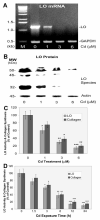The critical role of the cellular thiol homeostasis in cadmium perturbation of the lung extracellular matrix
- PMID: 19879314
- PMCID: PMC2814991
- DOI: 10.1016/j.tox.2009.10.021
The critical role of the cellular thiol homeostasis in cadmium perturbation of the lung extracellular matrix
Abstract
Cadmium (Cd) inhalation can result in emphysema. Cd exposure of rat lung fibroblasts (RFL6) enhanced levels of metal scavenging thiols, e.g., metallothionein (MT) and glutathione (GSH), and the heavy chain of gamma-glutamylcysteine synthetase (gamma-GCS), a key enzyme for GSH biosynthesis, concomitant with downregulation of lysyl oxidase (LO), a copper-dependent enzyme for crosslinking collagen and elastin in the extracellular matrix (ECM). Cd downregulation of LO in treated cells was closely accompanied by suppression of synthesis of collagen, a major structure component of the lung ECM. Using rats intratracheally instilled with cadmium chloride (30 microg, once a week) as an animal model, we further demonstrated that although 2-week Cd instillation induced a non-significant change in the lung LO activity and collagen synthesis, 4- and 6-week Cd instillation resulted in a steady decrease in the lung LO and collagen expression. The lung MT and total GSH levels were both upregulated upon the long-term Cd exposure. Emphysematous lesions were generated in lungs of 6-week Cd-dosed rats. Increases of cellular thiols by transfection of cells with MT-II expression vectors or treatment of cells with GSH monoethyl ester, a GSH delivery system, markedly inhibited LO mRNA levels and catalytic activities in the cell model. Thus, Cd upregulation of cellular thiols may be a critical cellular event facilitating downregulation of LO, a potential mechanism for Cd-induced emphysema.
2009 Elsevier Ireland Ltd. All rights reserved.
Figures










Similar articles
-
Lysyl oxidase, a critical intra- and extra-cellular target in the lung for cigarette smoke pathogenesis.Int J Environ Res Public Health. 2011 Jan;8(1):161-84. doi: 10.3390/ijerph8010161. Epub 2011 Jan 19. Int J Environ Res Public Health. 2011. PMID: 21318022 Free PMC article. Review.
-
Downregulation of lysyl oxidase and upregulation of cellular thiols in rat fetal lung fibroblasts treated with cigarette smoke condensate.Toxicol Sci. 2005 Feb;83(2):372-9. doi: 10.1093/toxsci/kfi019. Epub 2004 Oct 27. Toxicol Sci. 2005. PMID: 15509664
-
Inhibition of the expression of lysyl oxidase and its substrates in cadmium-resistant rat fetal lung fibroblasts.Toxicol Sci. 2006 Apr;90(2):478-89. doi: 10.1093/toxsci/kfj112. Epub 2006 Jan 23. Toxicol Sci. 2006. PMID: 16432278
-
Perturbation of copper (Cu) homeostasis and expression of Cu-binding proteins in cadmium-resistant lung fibroblasts.Toxicol Sci. 2007 Sep;99(1):267-76. doi: 10.1093/toxsci/kfm158. Epub 2007 Jun 20. Toxicol Sci. 2007. PMID: 17584760
-
Cadmium adaptation in the lung - a double-edged sword?Toxicology. 2001 Mar 7;160(1-3):65-70. doi: 10.1016/s0300-483x(00)00436-4. Toxicology. 2001. PMID: 11246125 Review.
Cited by
-
The Core Promoter and Redox-sensitive Cis-elements as Key Targets for Inactivation of the Lysyl Oxidase Gene by Cadmium.J Nat Sci. 2015 Feb 1;1(2):e38. J Nat Sci. 2015. PMID: 25741534 Free PMC article.
-
Lysyl oxidase, a critical intra- and extra-cellular target in the lung for cigarette smoke pathogenesis.Int J Environ Res Public Health. 2011 Jan;8(1):161-84. doi: 10.3390/ijerph8010161. Epub 2011 Jan 19. Int J Environ Res Public Health. 2011. PMID: 21318022 Free PMC article. Review.
-
Impact of acute and chronic inhalation exposure to CdO nanoparticles on mice.Environ Sci Pollut Res Int. 2016 Dec;23(23):24047-24060. doi: 10.1007/s11356-016-7600-6. Epub 2016 Sep 16. Environ Sci Pollut Res Int. 2016. PMID: 27638805
-
Hypoxia-response element (HRE)-directed transcriptional regulation of the rat lysyl oxidase gene in response to cobalt and cadmium.Toxicol Sci. 2013 Apr;132(2):379-89. doi: 10.1093/toxsci/kfs327. Epub 2012 Nov 17. Toxicol Sci. 2013. PMID: 23161664 Free PMC article.
-
Cadmium-induced apoptosis of Siberian tiger fibroblasts via disrupted intracellular homeostasis.Biol Res. 2016 Oct 24;49(1):42. doi: 10.1186/s40659-016-0103-6. Biol Res. 2016. PMID: 27776532 Free PMC article.
References
-
- Anderson ME, Powrie F, Puri RN, Meister A. Glutathione monoethyl ester; preparation, uptake by tissues, and conversion to glutathione. Arch. Biochem. Biophys. 1985;239:538–548. - PubMed
-
- Bedell-Hogan D, Trackman PC, Abrams W, Rosenbloom J, Kagan HM. Oxidation, crosslinking and insolubilization of recombinant tropoelastin by purified lysyl oxidase. J. Biol. Chem. 1993;268:10345–10350. - PubMed
-
- Chen L-J, Zhao Y, Gao S, Chou I-N, Toselli P, Stone P, Li W. Downregulation of lysyl oxidase and upregulation of cellular thiols in rat fetal lung fibroblasts treated with cigarette smoke condensate. Toxicol. Sci. 2005;83:372–379. - PubMed
-
- Chou DK, Zhao Y, Gao S, Chou I-N, Toselli P, Stone P, Li W. Perturbation of copper (Cu) homeostasis and expression of Cu-binding proteins in cadmium-resistant lung fibroblasts. Toxicol Sci. 2007;99:267–276. - PubMed
-
- Davidson JM. Biochemistry and turnover of lung interstitium. Eur. Respir. J. 1990;3:1048–1063. - PubMed
Publication types
MeSH terms
Substances
Grants and funding
LinkOut - more resources
Full Text Sources

